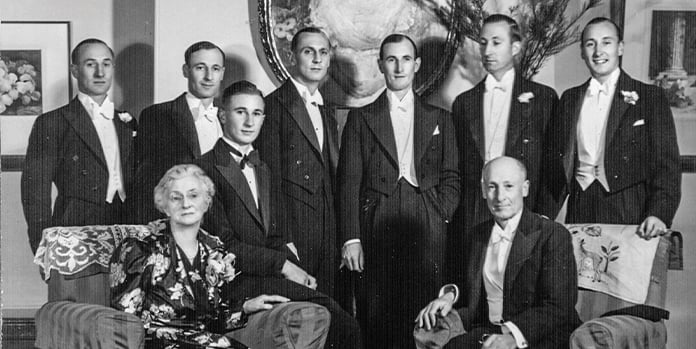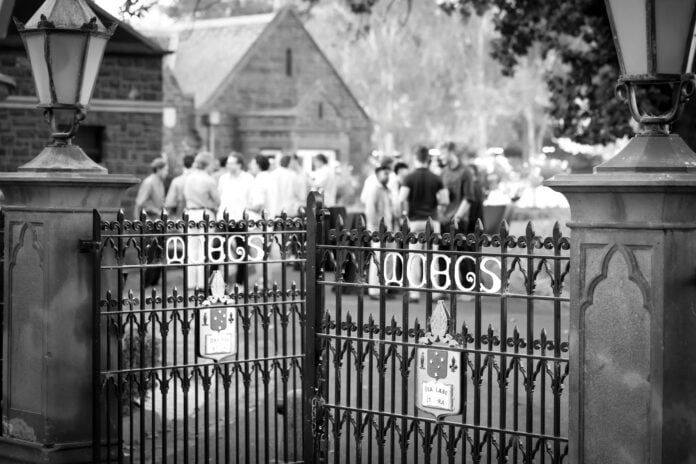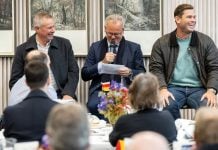Arthur Octavius Barrett (OM 1887) was a remarkable man. He may be best known to the Melbourne Grammar School community as the name on the Barrett Gates which has served as the main entrance to the School on St Kilda Road since 1928, but there is much more to his story.
A lifelong association with the School
Arthur Barrett’s association with Melbourne Grammar School began in 1886, when he entered Senior School as a student. His three younger brothers Alfred Barrett (OM 1887), Harold Edwin Barrett (OM 1889) and Norman Rupert Barrett (OM 1892) joined him in later years.
Involvement in the School continued throughout his life. Arthur was a member of School Council from 1931 to 1932. He also served on the Old Melburnians Council from 1909 to 1914, and was its President from 1931 to 1932.
An outstanding athletic walker who held the 3 Mile Walk Australasian title in 1893, Barrett contributed his expertise in the sport to the School through coaching and judging at Athletics sport carnivals over
the years.
Along with his seven sons, all of whom attended the School, Barrett gifted the wrought iron gates on St Kilda Road to Melbourne Grammar in 1928.
Their gift also included the realignment of the driveway from the gate which travelled around the newly created Steele Memorial Ground, past The Old Melburnians War Memorial Hall, and into Bromby Street. The path essentially remains the same today.
The Gates, the Steele Oval, and The Old Melburnians War Memorial Hall were all formally dedicated on 11 November 1928.
Revitalising the Steele Oval
However, in 1932, Barrett had an extraordinary impact on the lives of Melbourne Grammar students for generations to come.
Although the surface of the Steele Oval had been regraded when it was established in 1928, it soon became apparent that grass would not grow on it and consequently students could not play on it. This is where one of Barrett’s great strengths came to the forefront.
Alongside his professional roles, Barrett was an outstanding amateur naturalist and an early Australian environmentalist.
Through experimentation, observation and other research, Barrett built an extraordinary level of botanical expertise. His particular interest was safeguarding the quality of soil and water in Australia and built an impressive level of knowledge about both of these environmental elements.
In 1932, on the basis of his proficiency, he volunteered to address the Steele Oval situation and, as result of his careful and considered replacing of the soil and subsoil of the oval, a grassed playing field grew within the same year. Barrett took further steps over the next four years to fully liberate the soil from the clay rock which had been dumped there in c1896 during the construction of the cable tramway along St Kilda Road.
At age 67, Barrett documented his knowledge and understanding in his 205-page book Australia’s Entails. Published in 1937, it was dedicated to “the man in the street” and, along with a large section simply titled ‘Soil’, it included chapters titled ‘Why Australian trees are best for Australia’ and ‘Why the rivers used to run copiously’.
The book also documented the steps he took to remedy the Steele Oval soil issue, and the reasoning behind them, in some detail.
Barrett presented a copy to the School Library in the same year it was published and that book is still held in our Rare Books collection.
His other published works include The necessity for mature and over-mature Australian eucalypts on Australian watershed (1935), The effect of the eucalypts on the soil of Australia (1945), and Water conservation and Australia’s eventual population (1945).
A successful family business
Barrett’s parents and his siblings emigrated from England to Melbourne in 1885. Generations of the Barrett family had been masters in the making of malt – or maltsters, and Arthur Barrett, together with his two brothers, William and Alfred, continued that tradition in Melbourne. In 1894, they launched Barrett Brothers, Maltsters, and established a malthouse in Richmond, producing malt for beer, whisky and food products.
The family business evolved and significantly expanded over the years, with some of Barrett’s sons becoming heavily involved in the business. Various mergers and acquisitions occurred over time, including a notable one with Burston and Co in 1912. The final elements of the original business were sold and family involvement in the company ceased around 1960.
Arthur Barrett’s seven sons

Sir (Bob) Arthur George Barrett (OM 1912)
- Manager, Barrett Bros Ltd (South Australia)
- Served in Australian Flying Corps in WWI (1916 – 1919)
- Lord Mayor of Adelaide (1937 – 1940)
- Chairman of the South Australian branch of the Old Melburnians (1930 – 1931)
- Knighted in 1942 ‘in recognition of service to the community’
(Geoff) Geoffrey Charles Barrett (OM 1915)
- Managing Director, Barrett’s Food Co Pty Ltd (Melbourne)
- Served in Australian Flying Corps in WWI (1918)
- Member of Old Melburnians Council (1927 – 1930)
(Lance) Edgar Lancelot Barrett (OM 1920)
- Director, Union Maltings Pty Ltd (Perth)
- Served in the Royal Australian Naval Volunteer Reserve in WWII (1941 – 45)
- Honorary Secretary of the Western Australian branch of the Old Melburnians (1933 – 39)
(Harvey) Edward Harvey Barrett (OM 1924)
- Medical practitioner
(Alf) Alfred Ironside Barrett (OM 1925)
- Director, Barrett’s Food Co Pty Ltd (Melbourne)
- Racing car driver known as ‘the maestro’
- Served as Air Force Squadron Leader in WWII (1940 – 1941)
- Received King’s Commendation for ‘valuable service in the air’
(Rod) Roderick Corris Barrett (OM 1930)
- Director, Barrett’s Food Co Pty Ltd (Melbourne)
- Served in Australian Imperial Force in WWII (1941 – 1945)
(Gib) Julian St. Quentin Barrett (OM 1935)
- Engineer
- Racing car driver
- Served in RAAF in WWII (1941 – 1945)
The occupations included here are excerpts of those provided by the individuals and published in Liber Melburniensis Centenary Edition (1965).



